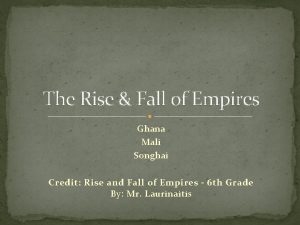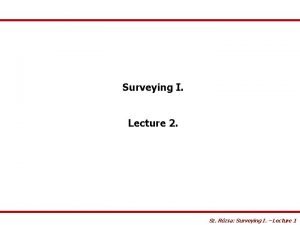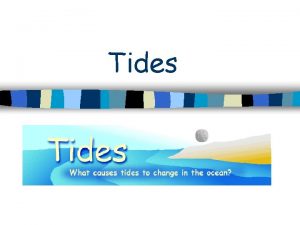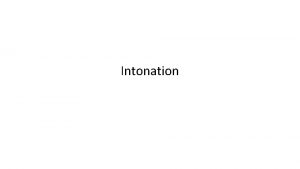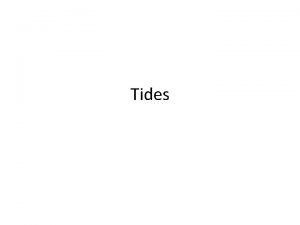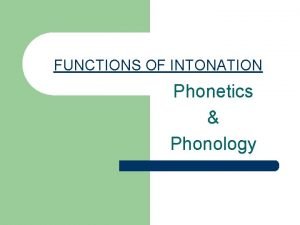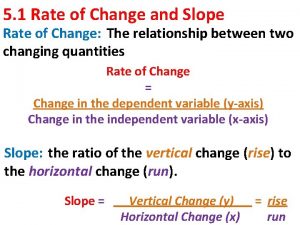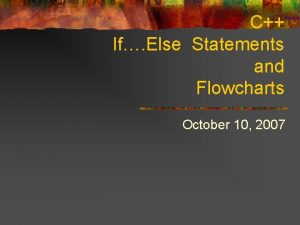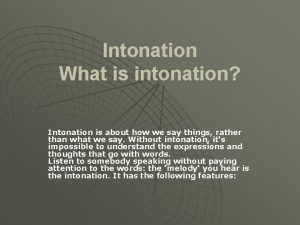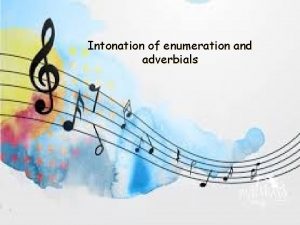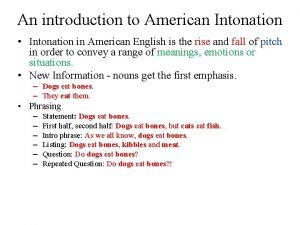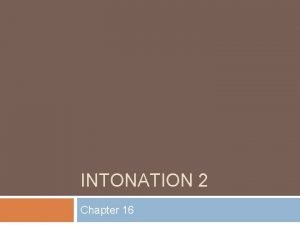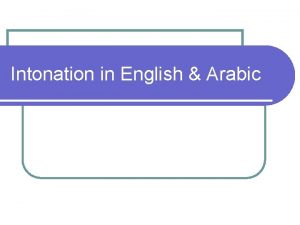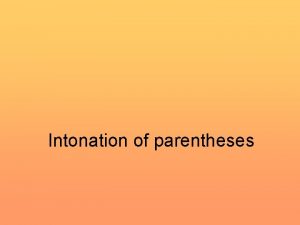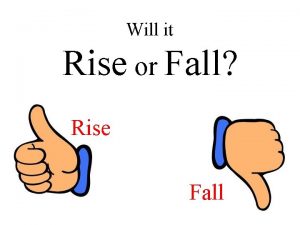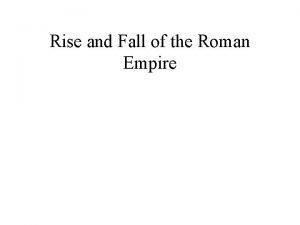Intonation Definition The rise and fall of the












































- Slides: 44

Intonation

Definition The rise and fall of the voice in speaking.

• Listening to (correct) English speech easily shows that: 1. In the course of a clause or sentence, the pitch of the voice is (nearly always) continually changing; and that 2. At the end of a clause or sentence (that is on the last important syllable, technically called the nucleus) the pitch of the voice falls in some cases and rises in other cases.

The forms of intonation • Five types, the first two are most common: A. A fall, or falling nuclear tone, often indicated ( ), which may be from a very high or mid pitch to a low or very low pitch;

B. A rise, or rising nuclear tone, often indicated , which may be from low to mid or from mid to high;


The functions of intonation • Sethi & Dhamija (2002): grammatical, attitudinal and accent functions.

• Grammatical: three roles. • Firstly: sentence types:

• Secondly, intonation helps the speaker divide longer sentences:

• Thirdly, intonation signals the precise kind of grammatical subordination of a relative clause to its main clause.

• In the attitudinal function intonation could be said to be the chief means by which the speaker conveys his attitudes and emotions.


Intonation used to differentiate sentences types Falling tone: a) Statements which are complete and definite

• b) Wh - questions which are matter-of-fact (unemotional and practical) and intended to be neither polite nor impolite.

c) Commands

d) Invitations

e) Exclamations

f) Tag-questions forcing the listener to agree with the speaker

Falling A. Statements which are complete and definite B. Wh - questions which are matter-of-fact and intended to be neither polite nor impolite. C. Commands D. Invitations E. Exclamations F. Tag-questions forcing the listener to agree with the speaker

9. 3. 2 Rising tone • a) Yes/no type questions

b) Statement intended to be a question

• c) Non-terminal tone group

d) Terminal utterance said as an afterthought

e) Request

• f) Command intended to sound like a request

• g) Wh-question showing politeness, friendliness, warmth and personal interest

• h) Repetition-question which repeats someone else's question, or wants him to repeat some information.

9. 3. 3 Falling-rising tone • a) Incomplete statement leading to a following statement

b) Statement intended to be a 'correction' of the information received

• c) Statement intended to be a warning/reproach or to express concern

• d) Imperative meant to be a pleading request

• e) Statement which shows a kind of reservation on the part of the speaker

9. 3. 4 Rising-falling tone • a) Statement showing enthusiastic agreement

b) Question showing suspicion, indignation or mockery

c) Imperative expressing petulance or haughtiness

d) Exclamation expressing sarcasm, irony

• When a plain statement of fact is said in a sentence of more than one clause: • (a) A fall is the normal intonation for the last tone group (and a rise for the first tone group) such as in:

• (b) A fall is used in both groups if the speaker thinks of them as two cumulative statements of fact, or if he adds the second as an afterthought such as in:

• (c) The two groups are said with a single intonation pattern and hence not marked for tone if the speaker thinks of it as an undivided statement; such as in:

• (d) A fall is used for the first group and a rise for the last if the speaker thinks of the first as the real remark, to which he adds the second as a reservation of afterthought such as in:

9. 4 Tones in relation to attitudes (a) Wh-questions • With falling tone signal matter-of-fact enquiries which are neither polite nor impolite such as in:

• (b) Tag-questions

• (c) Statements • With falling tone could signal matter-of-fact statements such as in: She's 'very 'beautiful.

• Continuation next class
 Tricky dick
Tricky dick Example of intonation
Example of intonation Example of falling intonation
Example of falling intonation Rise and rise again
Rise and rise again Little lambs academy
Little lambs academy A union b example
A union b example The periodic daily rise and fall of ocean water
The periodic daily rise and fall of ocean water Ghana empire dates
Ghana empire dates Napoleon's rise and fall assignment
Napoleon's rise and fall assignment Rise and fall method surveying
Rise and fall method surveying The fall of the qing dynasty
The fall of the qing dynasty Inverted staff reading in surveying
Inverted staff reading in surveying Spring tide and neap tide
Spring tide and neap tide Napoleon's rise to power timeline
Napoleon's rise to power timeline It is the rise and fall of the voice in speaking
It is the rise and fall of the voice in speaking Roman road
Roman road Rome rise and fall of an empire
Rome rise and fall of an empire Relevance lost the rise and fall of management accounting
Relevance lost the rise and fall of management accounting The periodic daily rise and fall of ocean water
The periodic daily rise and fall of ocean water The rise and fall of adolf hitler
The rise and fall of adolf hitler Greek civilization began in an area dominated by
Greek civilization began in an area dominated by Mali rise and fall
Mali rise and fall Rising and falling intonation
Rising and falling intonation The functions of intonation
The functions of intonation The rise fall andrew
The rise fall andrew Rising and falling intonation exercises
Rising and falling intonation exercises Greeting intonation
Greeting intonation Summary the reading public
Summary the reading public Rise of austria and prussia
Rise of austria and prussia Othello act 2 summary
Othello act 2 summary Area of low pressure where air masses meet and rise
Area of low pressure where air masses meet and rise Rise and run
Rise and run Rome and the rise of christianity
Rome and the rise of christianity Rise and shine primary school
Rise and shine primary school Her children shall rise up and call her blessed
Her children shall rise up and call her blessed Graph equations
Graph equations 5-1 rate of change and slope form g
5-1 rate of change and slope form g Isaiah 60 prophecy
Isaiah 60 prophecy Algorithm for if-else statement in c
Algorithm for if-else statement in c Zeus and the rise of the olympians
Zeus and the rise of the olympians Let us rise up and build
Let us rise up and build Let us rise up and build
Let us rise up and build The rise of napoleon and the napoleonic wars
The rise of napoleon and the napoleonic wars Artilarist
Artilarist Hình ảnh bộ gõ cơ thể búng tay
Hình ảnh bộ gõ cơ thể búng tay







